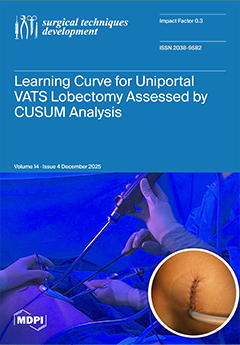Background: Septic arthritis of the hip (SAH) requires emergent surgical intervention. While open arthrotomy has been the traditional approach, arthroscopic treatment is emerging as an effective alternative. Tractionless techniques in adult populations remain understudied.
Methods: Twenty-one patients (22 hips) met inclusion criteria. Six
[...] Read more.
Background: Septic arthritis of the hip (SAH) requires emergent surgical intervention. While open arthrotomy has been the traditional approach, arthroscopic treatment is emerging as an effective alternative. Tractionless techniques in adult populations remain understudied.
Methods: Twenty-one patients (22 hips) met inclusion criteria. Six patients (7 hips) were excluded for age < 18 years, post-COVID osteomyelitis, prior hip surgery, or insufficient records, resulting in a final cohort of 15 patients. All fifteen patients underwent tractionless arthroscopic irrigation and debridement for suspected SAH (2014–2023). Inclusion required ≥2 clinical criteria (hip pain, limited range of motion, inability to bear weight, fever > 38 °C) AND ≥ 1 laboratory criterion (leukocytosis, elevated CRP, synovial WBC > 50,000, positive culture). Primary outcomes included Visual Analog Scale pain scores, inflammatory markers, and complications.
Results: Median age was 33 years (range 20–76); 60% were female. VAS scores improved from 7 (6–10) to 1 (0–3) at discharge (
p < 0.001). CRP levels decreased from 115 mg/L (35–206) to <5 mg/L (<5–9) postoperatively (
p < 0.001). Positive cultures were obtained in 26.7% of cases, predominantly methicillin-sensitive
Staphylococcus aureus. No perioperative complications occurred. Histopathological analysis revealed tenosynovial giant cell tumor (TGCT) in 33.3% of cases, representing an important differential diagnosis. Among non-TGCT cases, the culture-positive rate was 40%. No infection recurrence was observed during a minimum one-year follow-up.
Conclusions: Tractionless arthroscopic irrigation and debridement appears effective for managing suspected SAH in adults, achieving significant improvements in pain scores and inflammatory markers without perioperative complications. This technique offers potential advantages by eliminating traction-related risks while maintaining effective joint debridement. Additionally, TGCT should be considered in the differential diagnosis of suspected SAH with culture-negative inflammatory arthropathy.
Full article




